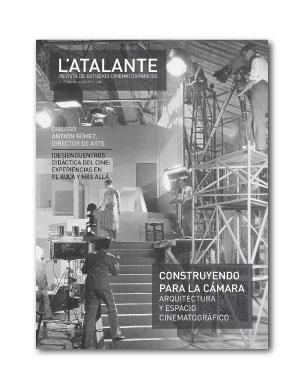Published 2014-01-01
Keywords
- Japanese film,
- manga,
- shôjo manga,
- manga-eiga,
- Shunji Iwai
- popular culture,
- floating text. ...More
How to Cite
Abstract
In contemporary popular Japanese culture, manga occupies a central position. The popularity of this cultural manifestation is evidenced in its capacity to influence other forms of artistic expression. This article studies this phenomenon at the cinematic level with the figure of Shunji Iwai, using three examples selected from his filmography. It analyzes the way in which Iwai appropriates certain characteristics of manga (especially the form for girls), such as the use of flowers and sparkles in order to surround the characters, floating text or complex perspectives and compositions with multiple points of view, elements that he puts into play in order to shape a language of his own that appears to explore the relationship between two media forms: the comic book and the moving picture.
Downloads
References
BERNDT, Jacqueline (1996). El Fenómeno manga. Barcelona: Martínez Roca.
BRYCE, Mio (2005). School in Japanese Children’s Lives Depicted in Manga. En Australian Association For Research In Education. AARE Conference Papers 2004 (pp. 1-22). Melbourne: AARE.
BUKATMAN, Scott (1993). Terminal identity: the virtual subject in postmodern science fiction. Durham: Duke University Press.
IWASAKI, Fernando (2011). Yasutaka Tsutsui en el Planeta Kyôgen. En Y. TSUTSUI, Paprika (pp. 9-14). Girona: Atalanta.
MADRID MORALES, Daniel; MARTINEZ TABERNER, Guillermo (2010). El Manga i l’animació japonesa. Barcelona: UOC.
—(2011). La Ola Nipona: consumo de cultura popular japonesa en España. En P. SAN GINÉS AGUILAR (Ed.), Cruces de Miradas, Relaciones e Intercambios. Granada: Editorial Universidad de Granada, pp. 49-61.
QUINTANA, Ángel (2007). Relato digital: regreso al cine de atracciones. En Pantallas depredadoras: el cine ante la cultura visual digital, ensayos de cine, filosofía y literatura (pp. 141-156). Oviedo: Universidad de Oviedo.
SALA, Ángel (2003). La asimilación post-moderna de los géneros populares japoneses. En R. LARDÍN (ed,). El principio del fin. Tendencias y efectivos del novísimo cine japonés (pp. 195-228). Barcelona: Paidós.
SCHODT, Frederik (1983). Manga! Manga! The World of Japanese Comics. New York: Kodansha International.
TAKAHASHI, Mizuki (2008). Opening the Closed World of Shojo Manga. En M.W. MACWILLIAMS (ed.), Japanese Visual Culture. Explorations in the World of Manga and Anime (pp. 114-136). New York: M.E. Sharpe.
THORN, Matt (2008). The Multi-Faceted Universe of Shôjo Manga. En MAISON DE LA CULTURE DU JAPON A PARIS, Le manga, 60 ans après... Recuperada de <http://www.matt-thorn.com/shoujo_manga/index.html> .
— (2001). Shojo manga. Something for the girls. Japan Quarterly, 48(3), pp. 43-50.
TOKU, Masami (2007). Shojo Manga! Girls’ Comics! A Mirror of Girls’ Dreams. En F. LUNNING (ed.), Mechademia 2: Networks of Desire (pp. 19-32). Minneapolis: U of Minnesota Press.

